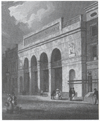In the late
second and early third decade of 1800, Antonio Lebolo was an Italian excavator
working for the Bernardino Drovetti, French consul general in Egypt.
Their digs were known to be in El Gournah, on the west bank of the Nile,
across from the ancient city of Thebes, which is the present city of Luxor,
After hours, on
his own time, Mr. Lebolo unearthed
a number of Ptolemaic mummies (from the period
of Greek influence in Egypt) , which became part of his personal
collection. These mummies appeared to be members of the priestly
class, who took great care to preserve their important papyri documents.
After Lebolo's death, an Italian man in Philadelphia was commissioned to serve as an agent for the Lebolo family to sell the mummies in the United States where 11 of these mummies and two papyrus rolls eventually found their way into the hands of a Mr. Michael Chandler.
Chandler began a traveling exhbition, in which, over a two year period, he sold the mummies to various agencies, including two to the Academy of Natural Sciences in Philadelphia. By the time Mr. Chandler arrived in Kirtland, Ohio, July 1835, he had only four mummies left.
While visiting the exhibit, Joseph Smith told church leaders then present, that he felt inspired that these scrolls contained important ancient scripture. After hearing this, several of the leaders pooled their resources, [including Joseph Coe and Simeon Andrews, who each contributed $800] and paid the astronomical $2,400 purchase price Chandler was asking for the remaining items in his exhibit.
After the sale, both the mummies and
the papyri were presented to Joseph Smith as a gift... with
the request that he teach these other brothern about the translation of
ancient egyptain. Which lead to Smith keeping notes in the margins
of the text as he translated...

| TEAM MEMBERS | WORKS CITED
CONTACT US @ WATER GLYPHS



